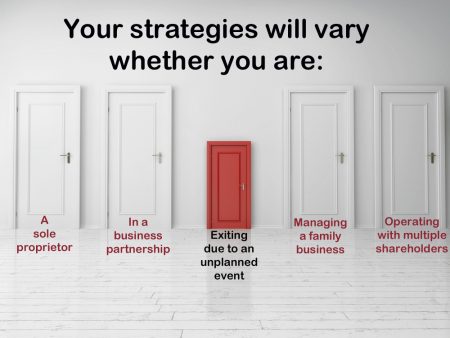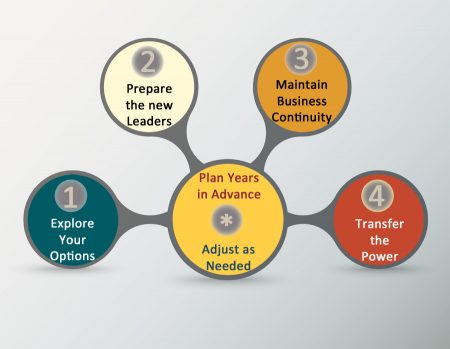Succession / Exit Planning
 Consider the day you committed to owning a business. That moment that you knew it was time to run your own business – for reasons only you can describe.
Consider the day you committed to owning a business. That moment that you knew it was time to run your own business – for reasons only you can describe.
What was the end goal? What motivated you to invest countless hours of time and resources to get the business off the ground and help it grow? Every owner’s reasons to embark on this path are different.
But one thing remains the same. The journey of business ownership reaches a “destination point” – where the owner decides it’s time to exit. As Alexander Graham Bell stated, “Above everything else, preparation is the key to success.” A well-planned exit strategy preserves the business legacy and helps achieve the owner’s original commitment to the business.
Having a solid succession plan will bring you peace of mind and personal satisfaction along with exciting and new opportunities for your business.
In our experience, we find that while nearly all business owners recognize the need for a succession plan, very few have actually implemented one. Cummings, Keegan & Co., P.L.L.P. is passionate about this topic and is determined to change that trend.
Important Considerations
Transferring your business will involve the consideration of a number of factors, including
- Is there an adult child or key employee to whom the business can be transferred?
- Does this person have the financial ability to buy the business?
- Do they have knowledge and experience to successfully operate the business?
- Are there other controlling shareholders to be considered?
- When will the transfer occur?
- What are the tax ramifications of transferring the business?
- What will be the next steps for the exiting owner? Will you retire or travel? Will you start a new business of philanthropic foundation?
- When is the appropriate time to transfer ownership?
Develop an Action Plan
 Follow our 4-step action guide to create your action plan for the succession. The plan works for every type of business, but the details and strategy will be unique to your own business. What works well for a small family-owned business likely will not be sufficient for a corporation. The details of each phase will need to be considered along with how they will uniquely impact your business.
Follow our 4-step action guide to create your action plan for the succession. The plan works for every type of business, but the details and strategy will be unique to your own business. What works well for a small family-owned business likely will not be sufficient for a corporation. The details of each phase will need to be considered along with how they will uniquely impact your business.
First and foremost, you will need to consider the needs of you and your family after the transition. What does that first day look like when you no longer go to the office? What will be your new routine? What will you “retire to”? In this phase, you will also consider who you would like to lead the business. You’ll explore various financial considerations for both the buyer and the seller, as well as determine the value of the business. You will go over some key planning decisions, such as tax and estate planning considerations.
During this phase, you will need to consider how best to transfer ownership. Who will have financial control? How will stock, real estate, and other assets be handled? You will need to determine who is best fit to lead the company from an operational perspective to ensure continued success. Does this person have the knowledge and skills to lead the company? Is there a knowledge gap that will need to be filled before transition is complete? How do you assess the successor’s skills? Will you provide proper training?
During this phase, you need to consider how the business will continue through an interruption – or without you due to an emergency. Here, it’s good to lay out a plan for the actual transition, but it’s also important to develop a plan if you face an unexpected absence from the company. Developing a contingency plan can help ensure “business as usual”, despite unexpected circumstances. This is often a good place to start for anyone considering an exit strategy because you define short-term strategies. This preparation helps ease any uncertainty when life happens, and the unplanned event occurs. Once again, “preparation is the key to success.”
Lastly, you will explore the best time to transfer ownership of the business. You’ll consider how to transfer in such a manner that causes as little interruption to the business as possible. You also need to explore what your future level of involvement will be and for how long you will maintain this level of involvement. You’ll test your plans on a small scale, sometimes easing into the transition. You’ll prepare yourself for the day that you have met your goal and hand over the keys.
It’s never too early to develop a succession plan. Planning early can help ensure you have considered all options, prepare for the unexpected, and ensure a smooth and successful transition.
Meet Peter Maddalena

I believe every owner should run the business like it’s for sale… even if it’s not.
Meet Kathy Klang

The earlier you plan for succession, the easier it is to practice letting go – and adapt the plan if needed.
